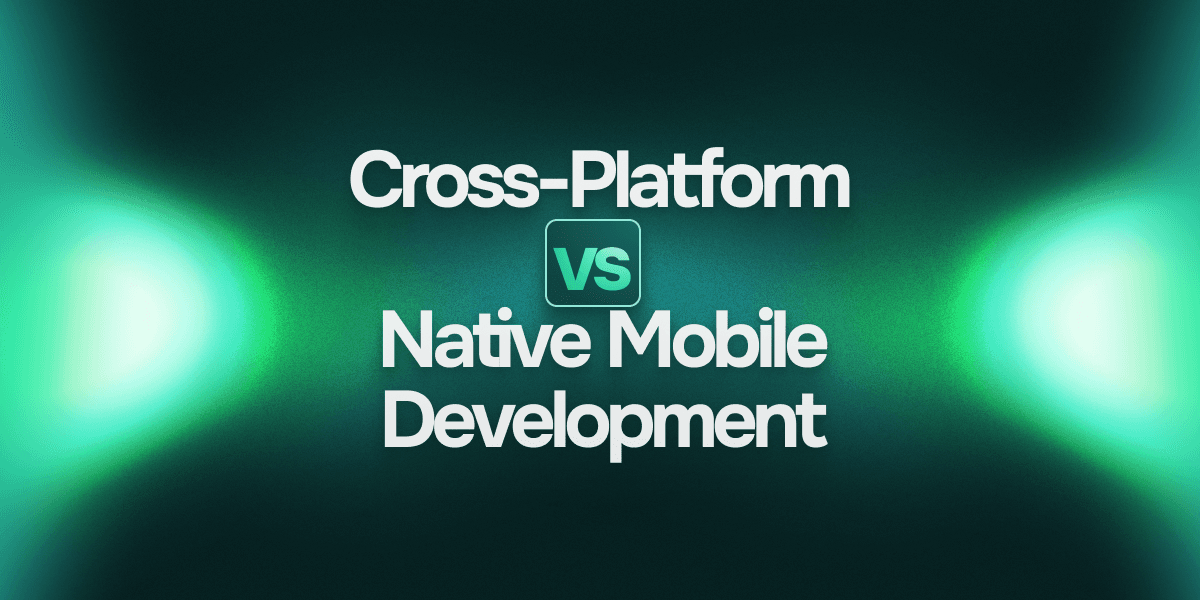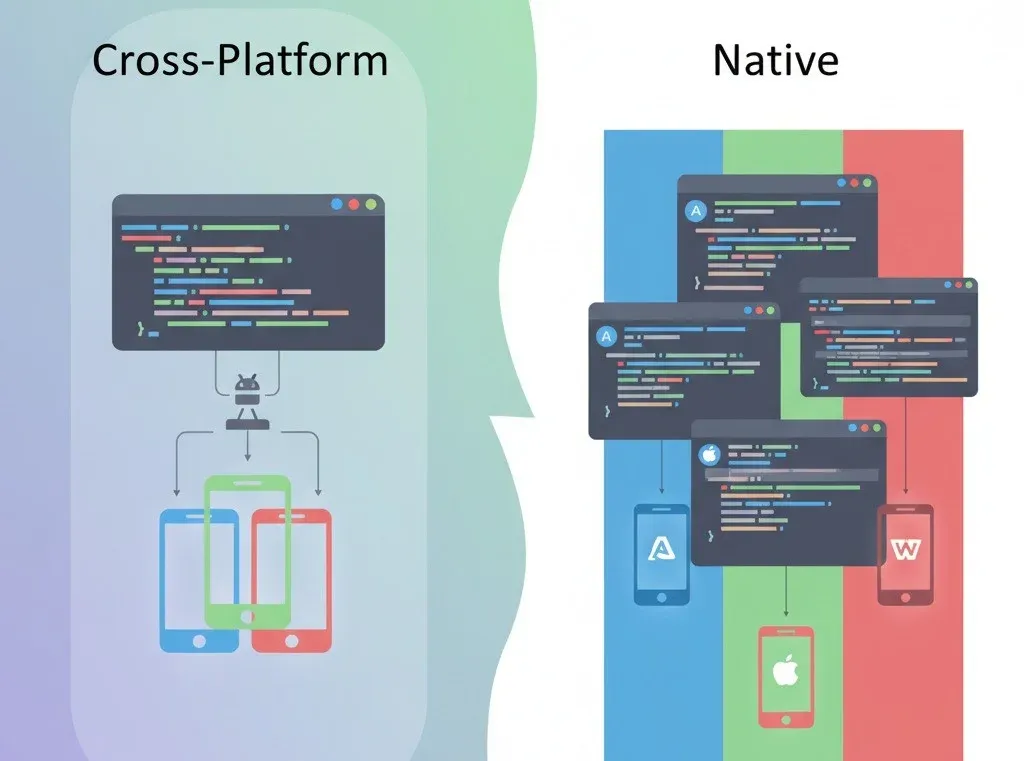
When it comes to building your mobile app, one decision will shape everything that follows. The choice between cross-platform vs native mobile development affects your budget, timeline, user experience, and long-term scalability in ways most founders don't fully grasp upfront.
This isn't just a technical decision; it's a business strategy that determines whether you'll launch fast and lean or invest heavily in platform-specific optimization. Pick cross-platform, and you might reach both iOS and Android users quickly while conserving resources. Choose native, and you could deliver superior performance, but at a significantly higher cost.
The thing is, there's no universally "right" answer when it comes to native vs cross-platform mobile app development. What matters is understanding how each approach aligns with your startup's current resources, goals, and growth plans.
What Do We Mean by Cross-Platform vs Native Mobile Development?
The mobile development world offers two distinct approaches, each with its own philosophy and trade-offs. Understanding these fundamental differences is crucial before diving deeper into which approach suits your startup best.
Native Mobile Development: The Platform-Specific Approach
Native development means building separate apps for each operating system using their specific programming languages and tools. Think of it as speaking each platform's native language fluently:
iOS apps: Built with Swift or Objective-C using Xcode
Android apps: Developed with Kotlin or Java using Android Studio
Complete platform access: Full access to every device feature and capability
Optimized performance: Apps run exactly as the platform intended
When you go native, you're basically creating two different products that do the same thing but are perfectly tailored to their respective platforms. Companies like Instagram and WhatsApp started this way because they knew their apps needed to handle millions of users without breaking a sweat.
Cross-Platform Development: The Unified Codebase Solution
Cross-platform development flips the script entirely. Instead of writing code twice, you write it once and deploy everywhere. Popular frameworks make this possible:
React Native: Facebook's solution, great for teams with React experience
Flutter: Google's framework with near-native performance
Xamarin: Microsoft's platform, ideal for enterprise applications
Single codebase: Write once, run on both iOS and Android
Companies like Airbnb, Uber Eats, and Discord have built successful apps this way. The basic idea is simple: why do the same work twice when you can do it once and get double the coverage?

Comparing Cross-Platform vs Native Development: Key Factors for Startups
Your startup's success depends on making informed decisions with limited resources. The choice between cross-platform development vs native development affects four critical areas that can make or break your mobile product.
Development Cost and Budget Control
Let's talk money because for most startups, that's what it all comes down to. The cost difference between cross-platform or native mobile development can be huge:
Native development costs:
Separate teams for iOS and Android (or developers who know both)
60-100% higher development costs compared to cross-platform
More complex project management with two codebases
Higher ongoing maintenance costs
Cross-platform advantages:
A single development team can handle both platforms
Reduced staffing costs and project complexity
Faster development cycles mean lower overall costs
Take Slack as an example—they started with web technologies wrapped in native containers to save money and get to market quickly. Once they had users and revenue, they could afford to invest in more native solutions for better performance.
Time-to-Market and MVP Speed
Time is everything in the startup world. The speed difference between native vs cross-platform mobile app development can literally make or break your launch:
Cross-platform speed benefits:
30-50% faster time-to-market
Simultaneous releases on both platforms
Quicker bug fixes across all versions
Perfect for MVP testing and user feedback cycles
Native development timeline:
Longer development cycles but more stable results
Sequential or parallel development for each platform
More thorough testing, but slower iterations
For early-stage startups, speed often trumps perfection. Getting your app in users' hands quickly lets you validate your idea and iterate based on real feedback, rather than spending months building something nobody wants.
User Experience and Performance
User experience can make or break your app, especially when you're trying to build trust with early adopters. The performance gap between cross-platform vs native development has narrowed, but differences still exist.
Native apps typically feel smoother because they're built specifically for each platform. They handle complex animations better, integrate seamlessly with platform features like Face ID or Android Pay, and generally feel more "at home" on each device.
Cross-platform apps have come a long way, though. Flutter, in particular, delivers performance that's nearly indistinguishable from native for most app types. The main limitations show up in graphics-heavy apps or when you need deep system integration. For content-driven apps, social platforms, or business tools, cross-platform solutions work great.
Scalability and Long-Term Maintenance
Your startup's growth plans should influence your technology choice today. The scalability differences between cross-platform development vs native development become more important as your user base and feature set expand.
Cross-platform development shines in maintenance efficiency. Bug fixes, feature updates, and security patches only need to be implemented once instead of twice. This unified approach reduces the chance of inconsistencies between your iOS and Android versions and makes it easier for small teams to manage complex applications.
Native development offers better scalability for features that require deep platform integration. As your app grows and users demand more sophisticated functionality, native development provides more flexibility and access to cutting-edge platform features. However, maintaining two separate codebases requires more resources and coordination.
Many successful companies start with cross-platform development and selectively move critical components to native solutions as they scale. This hybrid approach allows startups to balance speed and cost with performance and flexibility.
Cross-Platform or Native Mobile Development? Startup Use Cases
Different startup scenarios call for different approaches. Understanding when each development method makes sense will help you align your technical decisions with your business goals.
When Cross-Platform Makes Sense for Startups
Cross-platform development is perfect for certain startup scenarios:
You need to validate your idea quickly with an MVP
Budget is tight, and you can't afford separate development teams
Your app is content-driven (news, social media, business tools)
You have a small development team or limited technical resources
Getting user feedback and iterating quickly is more important than perfect performance
Think about apps like news readers, social platforms, or productivity tools—they work great with cross-platform frameworks because they don't need intensive graphics or deep hardware integration.
When Native Development Is the Better Choice
Some startup types should seriously consider native development despite the higher costs:
Gaming or AR/VR applications that need top-tier performance
Apps with heavy graphics, complex animations, or intensive processing
IoT applications or device companions that need hardware integration
Apps where smooth performance is a competitive advantage
Products with proven demand and clear scaling plans
If your app's success depends on being buttery-smooth or accessing cutting-edge device features, the extra investment in native development usually pays off. Users can tell when an app feels sluggish or doesn't integrate well with their device.

Expert Recommendations for Startups in 2025
The mobile development ecosystem has matured significantly, offering startups better tools and frameworks regardless of which approach they choose. Making the right choice requires understanding both current options and future implications.
Cross-Platform Framework Recommendations
The cross-platform world has some solid options now:
Flutter: Google's framework with excellent performance and growing popularity
React Native: Great if your team already knows React, huge community
Xamarin: Microsoft's solution, best for enterprise-focused startups
Flutter has become the go-to choice for many startups because it delivers near-native performance and has strong backing from Google. Companies like BMW and eBay use it successfully.
Native Development Tools and Languages
iOS development has standardized around Swift, which Apple designed to be more approachable than its predecessor, Objective-C. Swift's modern syntax and strong performance make it an excellent choice for startups building iOS-first applications or requiring maximum performance on Apple devices.
Android development now primarily uses Kotlin, which Google officially supports and prefers over Java. Kotlin's interoperability with existing Java code and its more concise syntax make it the clear choice for new Android projects.
Making the Strategic Decision
Choosing between cross-platform vs native mobile development comes down to your specific situation. Ask yourself these questions:
Budget constraints: How much can you realistically spend on development?
Timeline pressure: Do you need to launch quickly to beat competitors?
Performance requirements: Is your app graphics-heavy or performance-critical?
Team expertise: What skills does your development team already have?
Long-term plans: Will you need advanced platform features as you scale?
Cross-platform frameworks can reduce development time by approximately 30-40%, making them attractive for budget-conscious startups. Remember, this isn't a permanent decision. Many successful companies start cross-platform and selectively move critical components to native as they grow and learn what their users actually need.
Conclusion
There's no magic formula for choosing between cross-platform or native mobile development. What works for one startup might be completely wrong for another. The key is being honest about where you are right now and where you want to go.
If you're bootstrapping and need to prove your concept quickly, cross-platform development probably makes sense. You can always level up later when you have more resources and clearer requirements. But if you're building something that demands top performance or deep platform integration from day one, it might be worth investing in native development upfront.
The most important thing? Don't let perfect be the enemy of good. Pick the approach that gets you to market with something users will love, then iterate from there. After all, the best technical architecture in the world won't save an app that doesn't solve real problems for real people.







